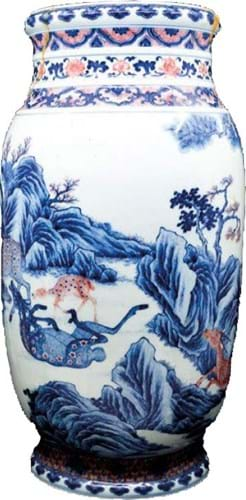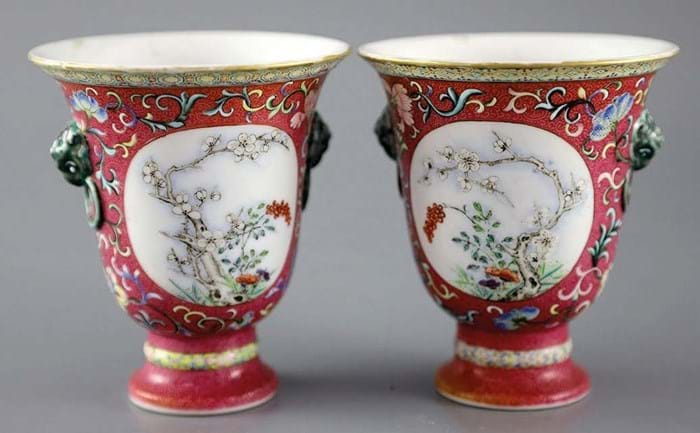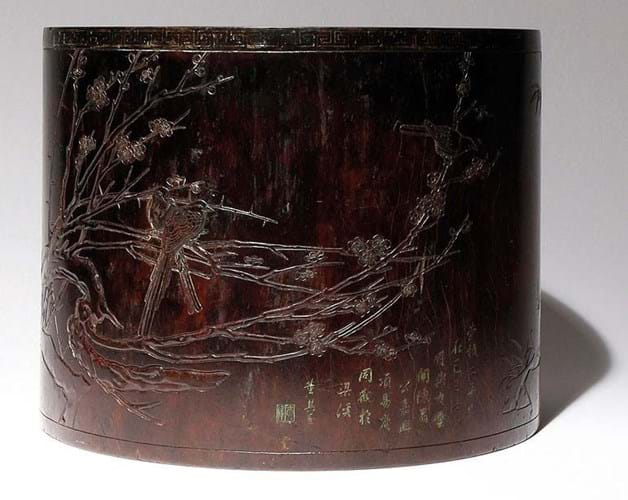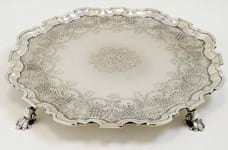Standing 18in (45cm) high, it is decorated with a herd of deer, including a red stag and blue doe, amid a mountainous landscape with pine trees and rock work.
The neck of the vase has parallel bands of similar auspicious symbols of cranes, clouds, lingzhi, prunus, fruiting peach branches and ruyi head motifs.
Large lantern vases of this type were a creation of the Qianlong period (this vase was probably made in the imperial kilns under the direction of Tang Ying in the 1740s) with the size and shape allowing a broad ‘canvas’ for decoration. A similar vase (with a hairline crack) sold for £625,000 at Duke’s in Dorchester in February 2010.
Hansons’ vase was discovered in a private Leicestershire house. It had been acquired by a local industrialist working in the China trade in the 1870s. It was in poor condition having been broken and reglued at the rim in nine pieces.
The damage was apparently the result of a hunting party in the 1950s. Estimated at £15,000-25,000 at the auction on December 7 in Etwall, Derbyshire, competition between 11 phone bidders plus online bidders pushed the hammer price to £200,000.
The winning bid came via a private buyer in China using thesaleroom.com.
Condition no barrier
Condition issues such as this are seldom a barrier to bidding for the best Qing porcelain. At Gorringe’s (23% buyer’s premium) in Lewes on December 8, £15,000 was taken for a pair of 4in (11cm) yangcai ‘New Year Longevity’ stem cups dating from the Qianlong or Jaiqing periods, c.1800.
One of the cups had been in half and the second cup has a small V-shaped section of the rim broken and reglued but they sailed above hopes of £2000-3000.
The decoration combines a sgraffito ruby ground plus medallions with prunus, lingzhi and sacred bamboo (nandina) which form the rebus: ‘May the fungus bestow longevity’. The reverse is inscribed xin nian ming bei (New Year longevity cup) with the base with an underglaze blue ‘hall mark’ zhu lin tang (Pearl Forest Hall).
Big brushpot
The Asian art sale at Woolley & Wallis (25% buyer’s premium) in Salisbury, also on December 7, was topped by a large Chinese brushpot (bitong) made in the much-revered hardwood zitan inlaid to the rim with silver wire.
Measuring an impressive 12in (30cm) across, it was estimated at £8000-10,000, but sold at £210,000.
Although dated to the Qing period the fine quality carving of birds perched amid prunus and bamboo in a rocky landscape includes an inscription with a date for the second year of the doomed reign of Chongzhen (1627-44 and the last of the Ming emperors) corresponding to 1630. The inscription, signed Dong Qichang, refers to a Chen Meigong admiring this piece at the Xiang Yi An temple in the city of Jiaxing.
‘Bird and tree’ bowls
A pair of 3¾in (9cm) Chinese porcelain blue and white bowls offered at Gardiner Houlgate (20% buyer’s premium) on November 26 had Chenghua (1447-87) marks but more probably date from the Yongzheng period (1722-35).
Painted with a pair of birds and fruiting trees to the exterior and to the interior with five Sanskrit characters, they are inspired by Ming prototypes.
Several similar ‘bird and tree’ bowls have sold in recent memory including a group of three that took an unexpected £130,000 at Christie’s in London on November 3.
The pair came for sale in Corsham, Bath, by descent from the estate of Roy Moodie, a financier with the Hong Kong and Shanghai Banking Corporation in the 1950s.
Estimated at £20,000-30,000, they sold at £64,000.


















